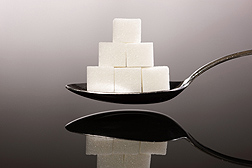| Read the magazine story to find out more. |
|
|
The Not-So-Sweet Truth About Sugars
By Rosalie Bliss
April 14, 2016
Controversy exists over whether all sweeteners produce the same metabolic effects in consumers despite the sweeteners’ chemical similarities. A study conducted by U.S. Department of Agriculture (USDA) researchers indicates that consuming lower amounts of added sugars is a more effective approach to health than finding a sugar that is more neutral in terms of its health effects.
USDA Agricultural Research Service (ARS) nutritionist Susan Raatz and her colleagues at the Grand Forks Human Nutrition Research Center in Grand Forks, North Dakota, studied whether there is a difference in health effects between white table sugar, high fructose corn syrup (HFCS) and honey. They studied the metabolic and health effects of chronically consuming sugar, HFCS and honey in volunteers. All three sweeteners contain glucose and fructose but in slightly different proportions. The paper appeared in the October issue of theJournal of Nutrition.
The study consisted of 28 volunteers with normal glucose tolerance and 27 volunteers with impaired glucose tolerance. The second group was included because they may be particularly vulnerable to negative metabolic effects of added dietary sugars, including heart disease, elevated blood fats and blood pressure, and inflammation.
Researchers included 50 grams of carbohydrates daily in the volunteers’ diets from one of the three sweeteners: honey, white cane sugar and HFCS. Each of the sweeteners was fed to the volunteers for a two-week period in random order. The participants had a 1-2 week break between treatments. By substituting the sweeteners for other carbohydrates in the volunteers’ diets, the volunteers’ weight was maintained.
Volunteers in the two groups did not show any differences in blood sugar levels based on the dietary sugar source. In addition, blood levels of triglyceride, an indicator of blood fat concentrations (a marker for heart disease risk), increased in response to all three sugars tested.
The study was partially funded by the National Honey Board.
Read more about this research in the April 2016 issue of AgResearch. ARS is the USDA’s principal intramural scientific research agency.

